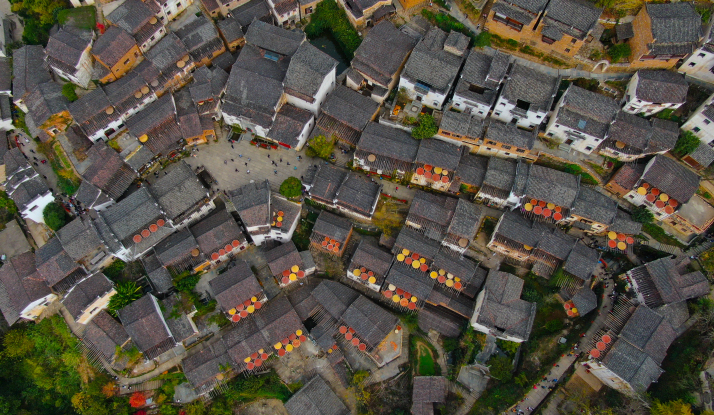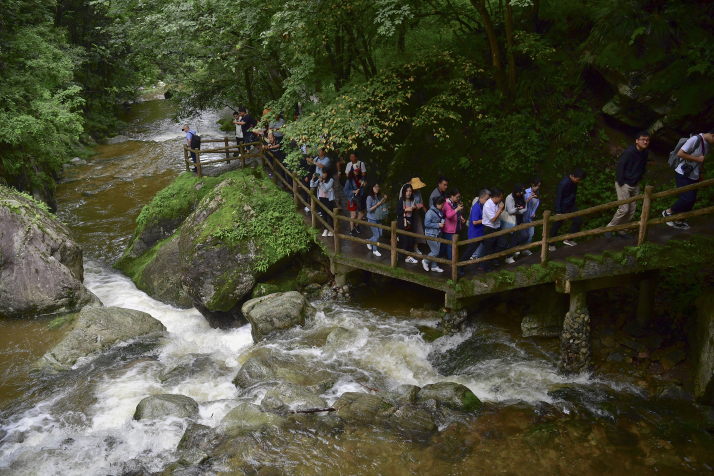| China |
| Four Chinese destinations named Best Tourism Villages in the world | |
|
|
 Farm produce dries in Huangling Village, Jiangxi Province, on November 7, 2019 (XINHUA)
On the roofs of ancient buildings, constructed on hillsides, peppers, unhusked rice and green beans are being dried in the autumn sun. The drying produce has become a unique sight in Huangling, an ancient village in Wuyuan County, Shangrao City in Jiangxi Province in east China.
The village, which was established more than 580 years ago, has over 100 buildings from the Ming (1368-1644) and Qing (1644-1911) dynasties, which are valuable subjects for the study of Hui-style architecture, an important branch of ancient Chinese architecture that features black roof tiles and white walls. However, in spite of its picturesque scenery and ancient buildings, the village used to be little known and very poor, so many villagers had to leave the village to go and make a living elsewhere. The turning point came more than 10 years ago, when the village established a tourism company to develop tourism in the village. The company invested 12 million yuan ($1.6 million) in building new homes for villagers living along the highway at the foot of the mountains surrounding the village. The dilapidated village buildings in which they once lived were refurbished and turned into homestays, and the terraced fields on the mountain slopes were planted with rapeseed flowers. The old buildings and rapeseed flowers create a distinctive scene. The village has launched new tourism products such as river drifting, hot springs and night tours to draw tourists. Relocated villagers return to the village to work at the scenic spot or have opened shops there themselves. Thanks to the development of tourism, the villagers' per-capita income is now more than 10 times what it was a decade ago. The village has recently earned a spot on the global Best Tourism Villages list for 2023 along with three other Chinese villages. The three other villages are Zhujiawan Village in Shaanxi Province, Xiajiang Village in Zhejiang Province and Zhagana Village in Gansu Province. The villages were named at the 25th Session of the United Nations World Tourism Organization (UNWTO) General Assembly in Samarkand, Uzbekistan, on October 19. China now has eight villages on the list, more than any other country in the world. The Best Tourism Villages is a global initiative launched by the UNWTO in 2021 to highlight those villages where tourism preserves cultures and traditions, celebrates diversity, provides opportunities and safeguards biodiversity. This year, 63 countries submitted 258 applications, resulting in the inclusion of 54 villages from 32 countries.  Tourists visit the Niubeiliang National Forest Park in Zhujiawan Village, Shaanxi Province, on September 22, 2020 (XINHUA) Tourism benefits Similar to Huangling Village, Zhujiawan, a village nestled in the Qinling Mountains in Shangluo, Shaanxi Province in northwest China, used to be an impoverished village. However, in recent years, it has harnessed the strength of its ecology to develop a tourism economy. The village is next to the Niubeiliang National Forest Park, which has a forest coverage rate of 93 percent and poor accessibility used to hinder the village's development. Zheng Chuanjia, a 39-year-old villager who now runs a homestay in the village, recalls that when he was a child, his family was so poor that they had only two meals a day. Things started to change with the drilling of a highway tunnel through the Qinling Mountains in 2007. Mao Jiafeng, Secretary of the Communist Party of China Zhujiawan Village Branch, told Xinhua News Agency that before the opening of the highway, it took four hours to travel to Xi'an, the provincial capital, from the village. Now, it takes around one hour. The convenient transportation has made it easy for tourists to visit the village. Seeing the increasing number of tourists, Zheng, who had found employment in urban areas after graduating from college, returned to the village to open a homestay. Today, his homestay has expanded from the previously one-story house to a three-story building which has 26 tables and 20 guestrooms and he now makes 200,000 to 300,000 yuan ($27,355 to 41,033) every year. Mao told Xinhua that, in the past, villagers relied on the mountains for a living by hunting and collecting herbs. Today they still rely on the mountains, but in a different way: The village now has eight forest rangers to protect the mountains and it is turning its ecological wealth into material wealth. One of the other villages on the global list, Zhagana, is located at an altitude of 3,000 to 3,300 meters and is surrounded by mountains, with the highest nearby peak reaching 4,500 meters. The name Zhagana means "stone box" in the Tibetan language, and the steep mountains and Tibetan-style houses form an ancient city enclosed by natural rock walls. The village has been transformed from an inaccessible mountainous village into a scenic spot where tourists can enjoy a slow and leisurely stay. More than 800 years old, Xiajiang Village in Zhejiang Province in east China has also made use of its pristine natural surroundings to develop tourism. It has created a diverse range of celebratory events, including camp carnivals and sorghum (a type of grain) festivals to breathe new life into the village. Wang Jinwei, an associate professor of tourism with Beijing International Studies University, told China Central Television that the UNWTO focuses mainly on nine areas in its selection process, including bio and cultural diversity, sustainable social development and community governance. For a village to excel in community governance, its rural tourism development must help create jobs to benefit local people. Wang added that the eight Best Tourism Villages from China are distributed across east, central and west China, which shows that China's rural tourism development has become more balanced. Dai Bin, President of China Tourism Academy, told Xinhua that the fact that China has the most Best Tourism Villages in the world shows how the country's rural tourism development is gaining global recognition. In the earlier stage of its development, rural tourism mainly offered basic experiences such as eating rural food, staying in rural houses and picking fruits and vegetables. Now, rural areas' beautiful natural environments, rich historical and cultural heritage and rural people's way of life have all become attractions for tourists. Dai said in this new stage of development, local tourism authorities should cater to tourists' needs and develop distinctive tourism products according to local conditions to promote the high-quality development of rural tourism. (Print Edition Title: Claim to Fame) Copyedited by G.P. Wilson Comments to jijing@cicgamericas.com |
|
||||||||||||||||||||||||||||||
|